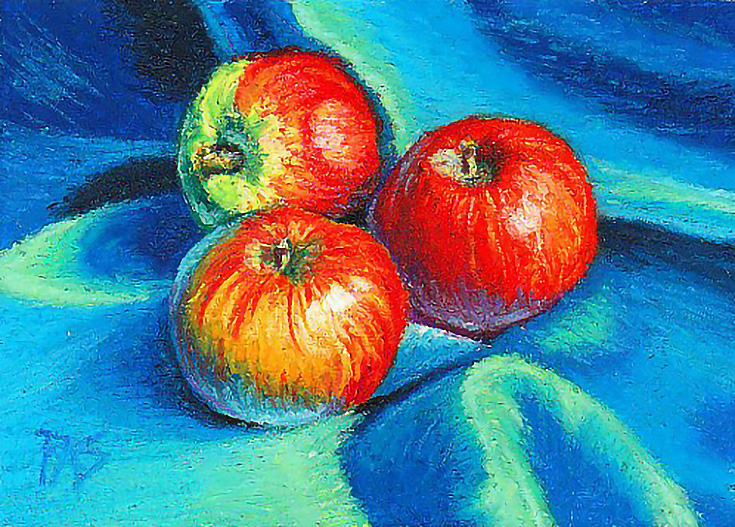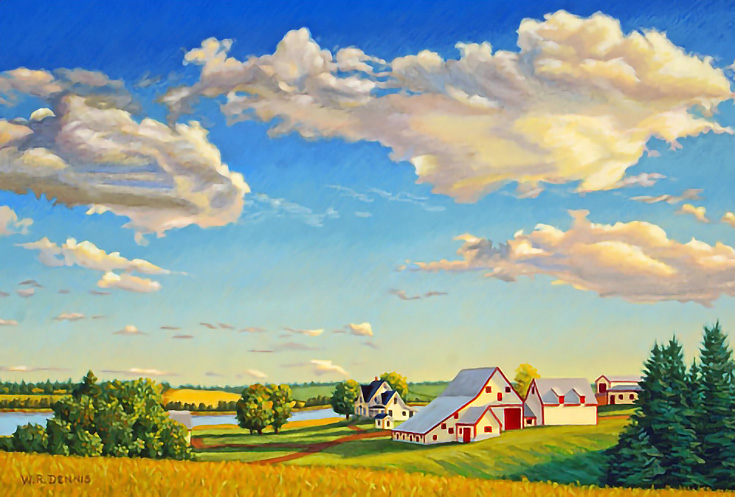All images in this article have been used with permission and are copyrighted by their respective artists. Click the images to visit the artists’ websites and learn more.
Why use oil pastels?
Oil Pastels are cost-effective.
The first time I saw a set of oil pastels was at a drugstore in a very small display of art supplies. It cost a dollar and change for a set of 24 and two dollars and change for a larger set of 36. The colors looked bright, the oil sticks were short, round, and wrapped, and the box cheerily announced that everything inside was nontoxic and safe for children.
I lumped it in with children’s watercolor sets and crayons, just from its price and presentation, and passed it by.
Later on, in New Orleans, when I was first starting out as a street artist, I reconsidered the medium. Compared to artist-grade colored pencils, oil pastels were very cheap.
Oil Pastels can be used to create oil paintings.
After studying a package, I discovered that I could thin them with oil mediums and realized that it would be an inexpensive way to do some oil paintings, so I picked up a set of 24, along with a bottle of turpentine and canvas boards, and I got started.
I wasn’t a very good painter, but the resulting thin-wash paintings were, as promoted, genuine oil paintings. I priced them appropriately between $5 and $10 and used the proceeds to buy tube oils and stretched canvases, soon leaving oil pastels behind. Nonetheless, using oil pastels can be fun and rewarding once you figure them out.
Tips and techniques for using oil pastels
Selecting oil pastel hardness
Like colored pencils, the hardness of each stick contributes to a different purpose. Many artists combine different brands of oil pastels to achieve different effects.
Firm brands like Cray-Pas Specialist or Erengi are better for early layers, fine details, and control. Softer products like Holbein or Sennelier can be used when the surface tooth is fully saturated over heavy layers of firm oil pastels.
Using oil pastels wet or dry
Oil pastels can be used wet or dry on any support: paper, board, canvas, glass, metal, wood. . . or even rock. Some surfaces work better with a coat of gesso, for preservation or more tooth, but you can be confident in using an oil pastel over any kind of round objects in a collage or mixed media piece.
Colors may be blended completely on the surface, scumbled over each other in layers, or blended on the palette and then applied with a knife or Color Shaper tool.
Keep in mind that they should not be applied heavily under a traditional oil painting without a good thinning of turpentine, as oil pastels have mineral oils in the binder that never completely dry. Treat them as “extra fat” in relation to oils in mixed media—the oil pastel layers should be the outermost.
As I discovered as a street artist in New Orleans, it’s also easy to use a wet brush to mix thin washes and paint directly from the oil pastel sticks, or just wash medium over areas already drawn for that blended look.
Tools for working with oil pastels
New tools have also made it easier to get fine detail and painterly effects. Rubber-tipped Color Shapers in both the gray firm texture or the dark gray Clay Shaper extra firm texture are very good for pushing color around and applying small details. (The soft white-tipped color shapers are better with soft pastels and should be kept separate.)
Sgraffito effects are much easier with oil pastels than with crayons. Laying a strong layer of white or a lighter color on first and then following it with other opaque layers allows you to scrape it back to reveal small details or create sharp lines in the work.
This is an old oil painter’s trick—often accomplished with the end of a brush—but it works just as well in oil pastels and is one of the important keys to realism.
How to use temperature to work with oil pastels
Temperature affects the firmness of all oil pastels, student or artist-grade. When warm, they’ll be softer and flow more easily. When cooled, they become more firm.
This can help in both directions—if your surface is saturated and won’t take more color, you can warm the pastels in your hand while the painting is in the fridge cooling to firmness. If your oil pastels are too soft to control (a common complaint about Senneliers) chilling them for a while should make them easier to handle.
Thin washes are also possible with any oil painting medium, from linseed oil to odorless turpentine or alcohol.
One oil pastel brand, Cretacolor Aqua Stic, is water soluble and has a medium-firm texture with a range of 80 colors. This allows artists to create partial-wash effects within the same painting. An area painted with any of the other oil pastel brands won’t melt when water is sprayed on to dissolve the Aqua Stic passages.
Another major advantage of Cretacolor’s Aqua Stic brand is that artists with a strong sensitivity to oil painting mediums can still use them. Aqua Stic oil pastels can also be combined with any other water-based mediums, yet are still firm enough to sharpen with a crayon sharpener or knife to get fine details.
Books for learning to use oil pastels
Two good books are available for oil pastels: Oil Pastel for the Serious Beginner and Oil Pastel: Materials and Techniques for Today’s Artist. The first is by John Elliott and the second is by Kenneth Leslie.
Either one is a good beginning book for artists interested in oil pastels, but Kenneth Leslie’s book is much more exhaustive and varied in its treatment of the medium.
To my pleasant surprise, both of these books demonstrated the gorgeous realism that can be achieved with artist-grade oil pastels. Just as with traditional oil paints or colored pencils, you can create strong Impressionist effects, layer colors, and re-work areas as necessary to get the fine detail of realism or hyper-realism.
Glazes, supports, travel considerations, etc.
Glazing oil pastel paintings
Oil pastel paintings should always be glazed when finished, unlike traditional oil paints which cure hard within a few months after finishing a painting. Some brands of oil pastels do harden somewhat, but not to the level that an oil or acrylic painting will, which means the surface can’t be dusted without smearing the paint.
Two brands of fixative are formulated specifically for oil pastels: Sennelier D’Artigny Oil Pastel Fixative forms a hard clear varnish with several thin applications and some artists will use it to just varnish heavily rather than glaze their finished paintings.
Caran d’Ache Protector Fixative is useful for preventing wax bloom, something that Neopastels may suffer from just as most colored pencil paintings do.
Best oil pastel supports (papers, etc.)
Traditional pastel papers and supports work just as well for oil pastels, especially the sanded pastel supports like Ampersand Pastelbord, Wallis Sanded Pastel Paper, and Colourfix Sanded Pastel Paper. Any extra tooth helps the artist add more layers and depth to the painting.
My personal favorite is Colourfix. Using clear Colourfix primer as a barrier over my sketches, I can keep my graphite or charcoal from blending into the lighter oil colors.
Traveling with oil pastels
Other advantages of oil pastels (besides being dustless) are their size, portability, and ease of use—especially for plein air applications. Many artists use oil pastels for field studies because the color ranges are just as vibrant as traditional oil paints, but much more handy for carrying around.
If you are flying to an exotic location and want to bring some art supplies, oil pastels should always be described as “artist crayons” to the customs people. (They’re nonflammable, non-explosive, and completely safe).
You’ll want to leave your mineral spirits at home, of course, and then pick some up once you arrive at your destination.
The more that I discover about oil pastels, the more interesting they become—and the more I realize that what you can do with this medium is only limited by your imagination and skill.
Oil pastel brands for sale today
Unlike soft pastels or colored pencils, professional oil pastels are not available from dozens of manufacturers. There are only a few good artist-grade brands, each of which has its own proprietary formula.
Sakura still produces Cray-Pas oil pastels, but in several grades—children’s Cray-Pas Junior Artist; student-grade round wrapped Expressionists, which many artists use for sketching to save money; and the last and best are artist-grade Cray-Pas Specialists, which are square wrapped sticks.
Cray-Pas Specialist pastels are the hardest oil pastel sticks you can find, followed in order of hardness by Cretacolor Aqua Stic, Erengi Art Aspirer, Caran d’Ache Neopastel and Holbein. The softest are Sennelier Oil Pastels which are now available in 120 colors.
Van Gogh Extra Fine Artist Oil Pastels are usually billed as good student-grade oil pastels, but share many qualities with these artist-grade brands. Depending on your application, they may be good enough to include in the list above.
Oil pastel prices are comparable to artist-grade colored pencils or soft pastels without quite reaching the price of high-end soft pastels.
In addition, only two brands, Holbein and Sennelier, include toxic mineral pigments such as Cadmiums and Cobalt. All others use strictly nontoxic hues.
What to buy when starting out
If you’re interested in trying artist-grade oil pastels you should either look for an inexpensive small set in one of the major artist-grade brands or choose your favorite painting colors and put together your own palette from open stock.
Compare open stock prices to the cost of sets—for some brands there’s no real bargain to buying large sets other than getting the box or tin designed to store them.
A short history of oil pastels
Before we wrap up, here’s some of the backstory behind oil pastels:
Professional-grade oil pastels have existed since 1949 when Henri Sennelier created a soft creamy oil pastel stick for Pablo Picasso.
The very first oil pastels were made in 1925 by Sakura and named Cray-Pas because they were a cross between the clean dustless ease of crayons and the brilliant saturated colors of traditional soft pastels.
Talens of Holland also created some Panda oil pastels in 1930, but the medium really took off when Picasso and painter Henri Goetz spoke to Henri Sennelier about creating something with traditional artist pigments.
Goetz wanted something he could use to start an oil painting: a sketch medium that would blend right in with painted layers. Picasso on the other hand just wanted to leave his brush behind and draw or paint directly on the canvas.
Sennelier ended up making a range of 48 colors that were heavy on the subtle grays and earth tones that Picasso requested. He produced 40 sticks of each color, and Picasso bought 3/4ths of those, so Sennelier put the remaining 10 of each in his shop where they sold out fast. Naturally, he continued to make them, and Senneliers became the first artist-grade oil pastel available.
Wrapping Up
Oil pastels are a great way to express yourself and can be very rewarding. They are easy to use and can create some really beautiful pieces of art. I definitely recommend giving them a try!
This post may contain affiliate links.






